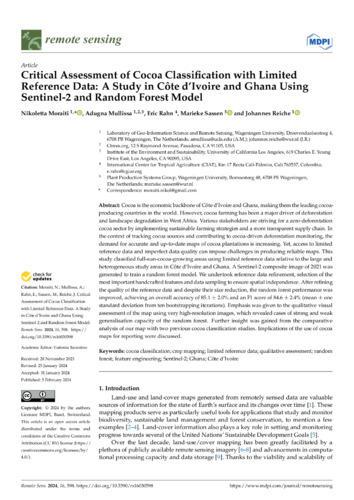Cocoa is the economic backbone of Côte d’Ivoire and Ghana, making them the leading cocoa-producing countries in the world. However, cocoa farming has been a major driver of deforestation and landscape degradation in West Africa. Various stakeholders are striving for a zero-deforestation cocoa sector by implementing sustainable farming strategies and a more transparent supply chain. In the context of tracking cocoa sources and contributing to cocoa-driven deforestation monitoring, the demand for accurate and up-to-date maps of cocoa plantations is increasing. Yet, access to limited reference data and imperfect data quality can impose challenges in producing reliable maps. This study classified full-sun-cocoa-growing areas using limited reference data relative to the large and heterogeneous study areas in Côte d’Ivoire and Ghana. A Sentinel-2 composite image of 2021 was generated to train a random forest model. We undertook reference data refinement, selection of the most important handcrafted features and data sampling to ensure spatial independence. After refining the quality of the reference data and despite their size reduction, the random forest performance was improved, achieving an overall accuracy of 85.1 ± 2.0% and an F1 score of 84.6 ± 2.4% (mean ± one standard deviation from ten bootstrapping iterations). Emphasis was given to the qualitative visual assessment of the map using very high-resolution images, which revealed cases of strong and weak generalisation capacity of the random forest. Further insight was gained from the comparative analysis of our map with two previous cocoa classification studies. Implications of the use of cocoa maps for reporting were discussed.
Moraiti, N.; Mullissa, A.; Rahn, E.; Sassen, M.; Reiche, J.

